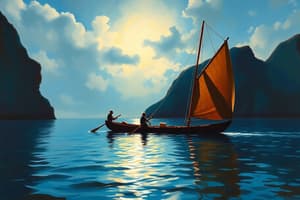Podcast
Questions and Answers
What feature distinguished Polynesian canoes?
What feature distinguished Polynesian canoes?
- Double hulls made from coa tree logs (correct)
- Made from metal
- Powered by sails exclusively
- Single hull design
Polynesian voyagers reached South America after Columbus.
Polynesian voyagers reached South America after Columbus.
False (B)
How many islands did Polynesian voyagers colonize?
How many islands did Polynesian voyagers colonize?
1,000
Polynesians built their canoes using traditional tools like ______.
Polynesians built their canoes using traditional tools like ______.
Match the following items with their descriptions:
Match the following items with their descriptions:
What year did Polynesians successfully settle the Hawaiian Islands?
What year did Polynesians successfully settle the Hawaiian Islands?
Polynesians were known for their navigation skills using the ocean currents and wind patterns.
Polynesians were known for their navigation skills using the ocean currents and wind patterns.
What is the significance of the term 'waka' in Polynesian exploration?
What is the significance of the term 'waka' in Polynesian exploration?
Polynesian voyagers covered over ______ million square miles of the Pacific Ocean.
Polynesian voyagers covered over ______ million square miles of the Pacific Ocean.
Match the following Polynesian accomplishments with their corresponding details:
Match the following Polynesian accomplishments with their corresponding details:
Flashcards are hidden until you start studying
Study Notes
Polynesian Voyagers
- Polynesian voyagers were the most successful navigators in history.
- They travelled across 7 million square miles of ocean to colonize 1,000 islands.
- Polynesian canoes were up to 60 feet long and featured double hulls made from coa tree logs.
- These canoes were built using traditional tools like adzes, and smaller wooden planks were sewn together.
- Crab cloth sails were woven from laala le and coconut fibers.
- It is believed that Polynesian voyagers reached South America between 1,000 and 1,200 AD.
- The odds of them reaching South America before Columbus are extremely high.
Pre-Columbian Exploration Theories
- The ocean acts as a highway for exploration, not a barrier.
- Pre-Columbian exploration relied on the idea that water is easier to cross than land.
- Mountains can isolate populations while water is far less of a barrier.
- The ability of Polynesians to reach remote islands in the Pacific makes it likely they reached North and South America.
Polynesian Voyagers
- Polynesian voyagers successfully traveled across 7 million square miles of ocean, colonizing over 1,000 islands.
- Their canoes, measuring up to 60 feet long, were constructed using traditional tools and featured double hulls made from coa tree logs.
- These canoes used crab cloth sails woven from laala le and coconut fibers.
- It is believed Polynesian voyagers reached South America between 1,000 and 1,200 AD.
Pre-Columbian Exploration Theories
- Water acts as a highway for exploration, making it easier to cross than land.
- Mountains can isolate populations, unlike water.
- The success of Polynesian voyagers reaching remote Pacific islands supports the possibility they reached North and South America.
Polynesian Exploration
- Polynesian explorers successfully settled the Marquesas and Hawaiian Islands around 1000 AD.
- Polynesian voyagers explored the Pacific Ocean and were the first to reach every distant island, covering more than 7 million square miles of ocean.
- Polynesians successfully colonized all 1,000 islands within their territory by 1380 AD.
- Polynesian voyagers navigated using the stars and their knowledge of the ocean currents.
- "Outrigger canoes" (called "waka" or "va'a") are notable for being among the most successful ships in history.
- "Waka" could be as long as 60 feet, with double hulls and a crab cloth sail.
- Polynesian seafaring methods were crucial for crossing vast distances, demonstrating that the ocean is not a barrier to exploration.
- Evidence suggests that Polynesians traveled to South America between 1000 and 1200 AD.
- The likelihood of Polynesian voyages to South America before Columbus is incredibly high.
Studying That Suits You
Use AI to generate personalized quizzes and flashcards to suit your learning preferences.




